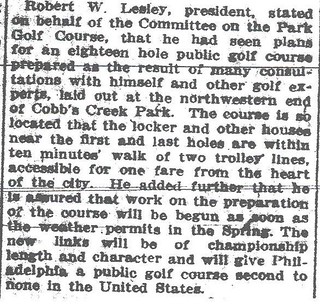From Mike Cirba:
All,
As most here have noted, I've seen those terms ("lay out", "laid out", "layout") all used as verbs and nouns during that time period to connote a variety of architecturally related functions including basic routing, on-the-ground hole "detailing", and feature construction. I think the meaning at any given time requires an accurate assessment as to the acutal historical timelining of the mention.
For instance, in the following article Robert Lesley talks about the plans he has seen "laid out" for a public course. In this case we know that this is something that exists only on paper, because it was published several months before construction of the golf course began. This is confirmed in a later paragraph when he mentions that work will actually begin on the course when the weather permits in the spring.

In my mind, this is similar in meaning to the following from the Merion Cricket Club Committee minutes from April 1911, which read, in part;
"On our return, we re-arranged the course and laid out five different plans. On April 6th Mr. Macdonald and Mr. Whigham came over and spent the day on the ground, and after looking over the various plans, and the ground itself, decided that if we would lay it out according to the plan they approved, which is submitted here-with, that it would result not only in a first class course, but that the last seven holes would be equal to any inland course in the world. In order to accomplish this, it will be necessary to aquire 3 acres additional."
“Whereas the Golf Committee presented a plan showing the proposed layout of the new golf ground which necessitated the exchange of a portion of the land already purchased for other land adjoining and the purchase of about 3 acres additional for $7,500, and asked the approval of this Board, on motion." In this case, once again we see that we're clearly talking about paper plans, or design plans, or if you will, routing plans. This was again talking about activities taking place before construction actually started. It's also clear that they are talking about paper plans when they say they showed the various plans to CBM, as well as when they "presented a plan showing the proposed layout" at the Board meeting.
In the case of the Merion Committee, I think it was largely a stroke of genius for them to have CBM come down and tell them which of their five plans he thought was the best. It probably not only helped them decide between any possible disagreeements among themselves in terms of which was best, but it also added gravitas to their recommendation to the board, given CBM's reputation. That these guys would seek outside opinions and work collaboratively really became a hallmark of their approach ongoing, and a really distinctive historical aspect to the Philadelphia School of Architecture, in my opinion.
Finally, I think the larger question here is this;
It's one thing to say that someone is going to lay out, or is laying out, or any of those terms that we agree cover a gamut of architectural and construction related activities.
However, I've seen very little contemporaneous writing that credits someone with "having laid out" a golf course where they are not also crediting that person with the architectural attribution. Perhaps in some cases where a very renowned course construction man like a Fred Pickering (who constructed hundreds of courses, including Merion East) is mentioned as having laid out a course, but seriously,
how many have seen contemporaneous reporting where someone is mentioned as having "laid out" a golf course can folks cite where they meant that person only was responsible for construction only and not architecture? Certainly any objective answer would concede that those cases are indeed rare exceptions and errors, and certainly not oft-reported and oft-repeated news articles for the remainder of that architect's life reported in the city of his residence.
Thanks,
Mike